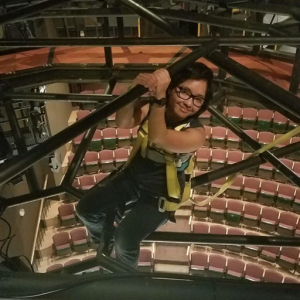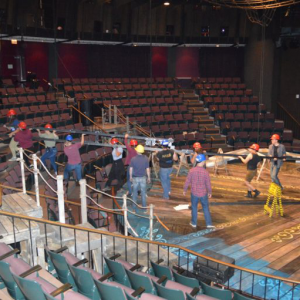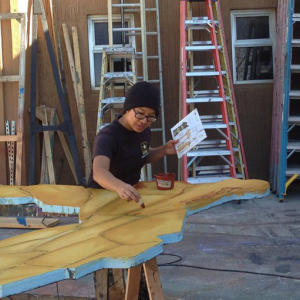- Demonstrate basic millinery knowledge and skill through its building with buckram.
- Identify basic fabric characteristics such as grain, bias, and weave.
- Determine fiber content through burn testing.
- Demonstrate basic dye techniques and fabric modification.
- Assess visual cues to determine period styles through knowledge and research.
Second Year Technical Training
Second Year Technical Training
In the second year, we focus on more advanced concepts and skills in all areas of training as we examine the realities of the professional entertainment industry. We explore job search and interview techniques and the business of being a marketable technician. Students in their second year attend the national the United States Institute for Theatre Technology’s national conference where they can explore new products, network, interview for jobs, and take workshops in all areas of technical theatre.
Costumes
Drafting
- Identify, interpret, and create various line styles, shapes, and line weights using the tools of computer-aided drafting both Vectorworks and AutoCAD.
- Learn how to edit 2D shapes and 3D objects while employing line conventions that comply with industry standards.
- Translating 2D and 3D drawn objects into printable products using viewports, and dimensions employing conventions that comply with industry standards.
- Creating symbols and grouped objects within a file.
- Learn how to develop and interpret drawings using industry-standard notation systems, visual styles, and page layout.
Electrics
- Discuss lighting careers outside of regional Theatre.
- Recognize a practical in a theatrical production.
- Build a working battery-operated practical for class.
- Identify different lighting beam angles.
- Better interpret Vectorworks drawings by creating a simple light plot.
- Organize instrument information in Lightwright.
Scenic Art
- Define key elements to think about when budgeting the paints aspect of a theatrical production.
- Acquire some more advanced techniques most often used in the painting of scenery and props in theatre.
- Analyze what steps and techniques to use to successfully create an example of an aged and distressed advertising sign that could be used in a theatrical production.
- Define key elements to think about when carving an ornament in bas relief out of foam.
- Analyze what steps and techniques to use to successfully create an example of traditionally painted foliage.
- Be able to verbally evaluate own process of scenic art.
Props
- Identify and understand the use of soft goods in the making of props.
- Identify and understand the use of plastics in the making of props.
- Demonstrate the proper way to mold and cast an object.
- Recognize different kinds of wood finishes.
- Demonstrate how to create paper props and other graphics.
Scenic Construction
- Understand the fundamentals of a safety design factor.
- Identify and understand the standards of different types of rigging hardware.
- Recognize and demonstrate various knots used in rigging.
- Develop methods and plans for constructing intermediate to advanced levels of scenery.
- Recognize and define different types and characteristics of staircases.
- Compare and contrast the different types of pneumatic automation from other types of automation used in the entertainment industry.
Sound
- Demonstrate an understanding of the signal flow of an intricate sound system.
- Gain an understanding of the roles of the Sound Engineer and Sound Designer.
- Obtain an introductory knowledge of sound editing through the use of ProTools.
- Learn how to read and generate paperwork for the intention of mixing a musical.
- Attain skills in active sound listening and ear training.
Stage Management
- Exhibit growth in different elements of Stage Management.
- Employ skills to work in Stage Management as well as other areas of theatre.
- Interpret information from rehearsals into blocking and paperwork.
- Experiment with tools and skills as they apply to Stage Management work.
- Evolve paperwork as more information is received and create meaningful ways of communicating.
- Combine skills, tools, and information learned to successfully execute calling a portion of a show.
Portfolio and Professionalism
- Demonstrate a willingness to accept and solicit feedback.
- Practice advanced self-analysis and evaluation of their own execution of techniques and skills acquired throughout the learning process.
- Demonstrate best practices for keeping a safe working environment.
- Demonstrate abilities to problem solve and adapt to challenging situations.
- Acquire advanced communication skills and time management abilities.
- Identify parts of a job ad and where to look for jobs.
- Locate appropriate job ads for their skill level.
- Create an appropriate cover letter based on a job ad.
- Modify their resume for a job ad and interview.
- Organize their portfolio (hardcopy and digital) for a specific job ad and interview.
- Research and prepare for an interview.
- Recognize and demonstrate interview skills.
- Present a functioning professional website with all the necessary parts.
- Demonstrate how to properly talk about their work and their work process with correct terminology and positive language.
- Demonstrate the ability to research activities, companies, and people in preparation for attending a national convention, USITT.
- Prepare branding materials such as resume and business cards.
- Exhibit networking skills.
- Compare their skills with others in the industry.


